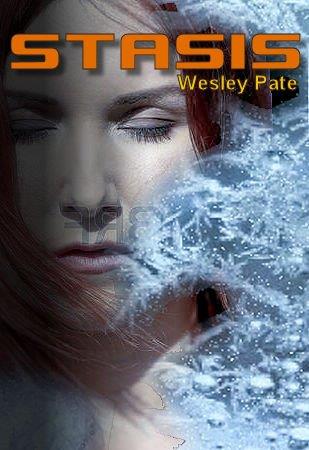The author says:
This is an updated cover concept I’m re-submitting for comment, based on several much-appreciated comments from the group. Because the new concept is such a diversion from the previous, I hope you’ll consider it in that light. As for the book, it’s a sci-fi novel targeted at adults. The story begins 50 years in the future as the protagonist and her husband travel to an exclusive resort on the Moon. A bioterrorist attack leaves most of the guests and staff infected with only days to live. The heroine goes into stasis to try and survive long enough until a cure can be found. She’s in and out of stasis for the next 200 years until the day arrives when she can take matters into her own hands.
[original submission and comments here]
Nathan says:
It’s a much more solid design than your first attempt. My two biggest comments are:
- Up the sci-fi factor — whether with the font, or adding an instrument panel, or something.
- There’s no need for the byline to be crowded into where it is, at the size that it is, when you’ve got all that empty real estate at the bottom.
Other comments?


I have to agree with Nathan: there is nothing that suggests that the story is science fiction. Nor is there anything to suggest the underlying theme of repeated awakenings over a long period of time.
The title might imply a science fiction theme, but it is pretty much overwhelmed by the non-science fiction artwork. I think this cover would not pass my test of imagining it with a title in an unfamiliar language. If you were to do that, would you still be able to tell anything at all about the nature, themes or even genre of the book?
Think of the things that you say your book is about: A setting on the moon 50 years in the future, bioterrorists, a deadly infection, a woman who is forced to go in and out of stasis over the following two centuries… The face of a woman behind what might be, so far as a potential reader might know, a frosty window is not sufficient to convey any sense of the time or place, or the situation the woman finds herself in.
You might be able to get the existing image—the sleeping face and ice—to work if you can work in one additional design element that carries the cover clearly across the line into science fiction or science fiction thriller. You need to be careful to not to try to include everything important—you want to avoid the kitchen sink school of cover design—but you do need to try to find something that helps to convey a little more of what the book is about and what kind of book it is.
PS
The dark shape in the lower middle of the art looks a little unfortunate when the cover is in thumbnail size.
once you see it, you can’t unsee it…lol
It was the first thing I noticed, sadly. Says a lot about my mind, I guess. Then it looked as though someone’s thumb imprinted, on the glass. (Weird). Either way..it’s not working.
I think if the text was all moved to the bottom, and a MUCH more sci-fi-y font were used, it would work. And the, er, thumb, needs to be omitted.
Oh, jeez…
I like it a lot. I might add a tag line not only to better sell it but to give it ‘words’ which covers in that genre have. I’d also put a layer mask on the ice and fade the edge out a bit because its a hair cut and paste as is. Nathans idea to make byline bigger is great. But I think I’d move all words to the bottom and not cut across her head at all. Also, to give that hint of sci fi and match genre put the slightest blue white glow beneath the ice. I love your color combos and this idea, it’s really great. I might also put an icy effect on the lettering or maybe a crack or two, I’d have to play around to decide. I love how the shadow on the title makes it look like its laying on glass and that effect could be heightened with a white gradient layer very faded with a scuffed texture overlay
You’re definitely getting where you’re trying to go with the concept, but the execution still needs a number of tweaks. For starters, with just the face and the frosted glass, prospective readers can’t automatically realize the protagonist is in suspended animation in a stasis pod; for all they know, she could just be closing her eyes for a moment while looking out a frosted window on some bitterly cold winter’s night. The title might be a clue, but with the genre not immediately apparent, they could just as easily think this is a bit of women’s literature about a gal retreating from her social life (into social “stasis”) after a nasty breakup.
The main problem, as I see it, is that this picture is literally a bit too close to its subject: you’ve zoomed in so close to your protagonist that we can’t see any of the stasis pod surrounding her. As a rule, covers for science fiction have to have some manner of technology on them; this one specifically needs to show the stasis pod. Also, having her face up and off to the left makes finding any immediate focal point for this cover rather difficult; I’d recommend pulling back just far enough so we can see the edges of her pod (with maybe a control panel and vital signs monitoring panel on either side to clarify what it is) and adjusting her placement on the cover so that those closed eyes of hers are perfectly centered.
Once you do that, the first thing your prospective readers see in the thumbnail is a sleeping woman beneath frosted glass, and then that the frosted glass is the window on the pod in which she’s resting comfortably, and then the title and the panels indicating that this is specifically a stasis pod. See how that works? Unlike cameras, which typically capture action by panning from one edge of a scene to another, the human eye usually jumps immediately to the center of any picture it’s given and only then starts spiraling out to the edges to make sense of what it’s seeing; that’s why putting your subject dead center (both horizontally and vertically) on your cover is usually the best strategy.
So yes, it’s good that you’ve taken our earlier advice and focused on your protagonist, but now you need to show us just enough of her surroundings to indicate the situation in which she’s entangled which is the central focus of the story. Also, having her pretty face at the center and the futuristic-looking technology of the pod on either side of her will leave you some real estate on the top and bottom of the cover for your nice big respective title and byline. As we like to tell authors who don’t print their bylines large enough, don’t be shy: as long as the title’s nice and large and legible in the thumbnail, there’s nothing particularly egotistical about making sure your byline’s similarly visible enough to announce to everyone that you wrote this (presumably) fine piece of literature and are proud of it.